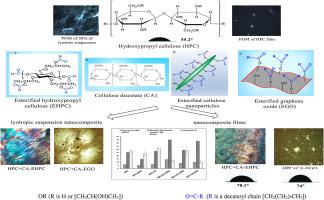羟丙基纤维素用于高性能可生物降解液晶和机械薄膜的裁剪
IF 5.2
2区 化学
Q2 CHEMISTRY, PHYSICAL
引用次数: 0
摘要
具有功能特性的可生物降解聚合物对于减少环境影响至关重要。本研究探讨了芦苇废弃物的升级利用,以提高羟丙基纤维素(HPC)薄膜的光学和力学性能。将改性纤维素纳米颗粒掺入HPC基质中,并与碳基纳米颗粒进行比较。利用x射线衍射(XRD)、傅里叶变换红外光谱(FTIR)、热重分析(TGA)、水接触角测量、力学测试、扫描电子显微镜(SEM)和光学显微镜,通过流变学和光学分析,研究了溶性悬浮液和固体纳米复合薄膜的液晶行为。结果表明,酯化纳米颗粒,特别是酯化纳米纤维素的加入,显著降低了HPC溶性溶液中各向异性相形成的临界浓度,从38% wt%降至32% wt%。单独使用纤维素纳米颗粒观察到最小的还原。在固体薄膜中,掺入酯化纳米颗粒,特别是与醋酸纤维素结合的酯化氧化石墨,显著增强了疏水性(接触角从55.2°增加到74°)、机械强度、热稳定性和结晶度。形态学分析证实了指纹纹理的存在,特别是在含有酯化纤维素纳米颗粒和氧化石墨的薄膜中。这些发现证明了酯化生物基纳米材料在推动功能性、可持续性液晶纳米复合材料发展方面的潜力。由于其增强的光学各向异性、机械强度、疏水性和热稳定性,所开发的hpc基纳米复合材料在生物可降解光学薄膜、可持续包装和智能环境传感器方面具有强大的应用潜力。本文章由计算机程序翻译,如有差异,请以英文原文为准。

Tailoring of hydroxypropyl cellulose for high performance biodegradable liquid crystal and mechanical films
Biodegradable polymers with functional properties are vital for reducing environmental impact. This study explores the upcycling of Giant Reed waste to enhance the optical and mechanical performance of hydroxypropyl cellulose (HPC) films. Modified cellulose nanoparticles were incorporated into the HPC matrix and compared with carbon-based nanoparticles. The liquid crystalline behavior was examined in both lyotropic suspensions—through rheological and optical analysis and in solid nanocomposite films using X-ray diffraction (XRD), Fourier Transform Infrared Spectroscopy (FTIR), thermogravimetric analysis (TGA), water contact angle measurements, mechanical testing, scanning electron microscopy (SEM), and optical microscopy. The results revealed that the addition of esterified nanoparticles, especially esterified nanocellulose, significantly reduced the critical concentration for anisotropic phase formation in HPC lyotropic solutions from 38 wt% to 32 wt%. The smallest reduction was observed with cellulose nanoparticles alone. In solid films, the incorporation of esterified nanoparticles, particularly esterified graphite oxide in combination with cellulose acetate, notably enhanced hydrophobicity (contact angle increased from 55.2° to 74°), mechanical strength, thermal stability, and crystallinity. Morphological analysis confirmed the presence of well-defined fingerprint textures, especially in films containing esterified cellulose nanoparticles and graphite oxide. These findings demonstrate the potential of esterified biobased nanomaterials to advance the development of functional, sustainable liquid crystal nanocomposites. The developed HPC-based nanocomposites show strong potential for use in biodegradable optical films, sustainable packaging, and smart environmental sensors, owing to their enhanced optical anisotropy, mechanical strength, hydrophobicity, and thermal stability.
求助全文
通过发布文献求助,成功后即可免费获取论文全文。
去求助
来源期刊

Journal of Molecular Liquids
化学-物理:原子、分子和化学物理
CiteScore
10.30
自引率
16.70%
发文量
2597
审稿时长
78 days
期刊介绍:
The journal includes papers in the following areas:
– Simple organic liquids and mixtures
– Ionic liquids
– Surfactant solutions (including micelles and vesicles) and liquid interfaces
– Colloidal solutions and nanoparticles
– Thermotropic and lyotropic liquid crystals
– Ferrofluids
– Water, aqueous solutions and other hydrogen-bonded liquids
– Lubricants, polymer solutions and melts
– Molten metals and salts
– Phase transitions and critical phenomena in liquids and confined fluids
– Self assembly in complex liquids.– Biomolecules in solution
The emphasis is on the molecular (or microscopic) understanding of particular liquids or liquid systems, especially concerning structure, dynamics and intermolecular forces. The experimental techniques used may include:
– Conventional spectroscopy (mid-IR and far-IR, Raman, NMR, etc.)
– Non-linear optics and time resolved spectroscopy (psec, fsec, asec, ISRS, etc.)
– Light scattering (Rayleigh, Brillouin, PCS, etc.)
– Dielectric relaxation
– X-ray and neutron scattering and diffraction.
Experimental studies, computer simulations (MD or MC) and analytical theory will be considered for publication; papers just reporting experimental results that do not contribute to the understanding of the fundamentals of molecular and ionic liquids will not be accepted. Only papers of a non-routine nature and advancing the field will be considered for publication.
 求助内容:
求助内容: 应助结果提醒方式:
应助结果提醒方式:


